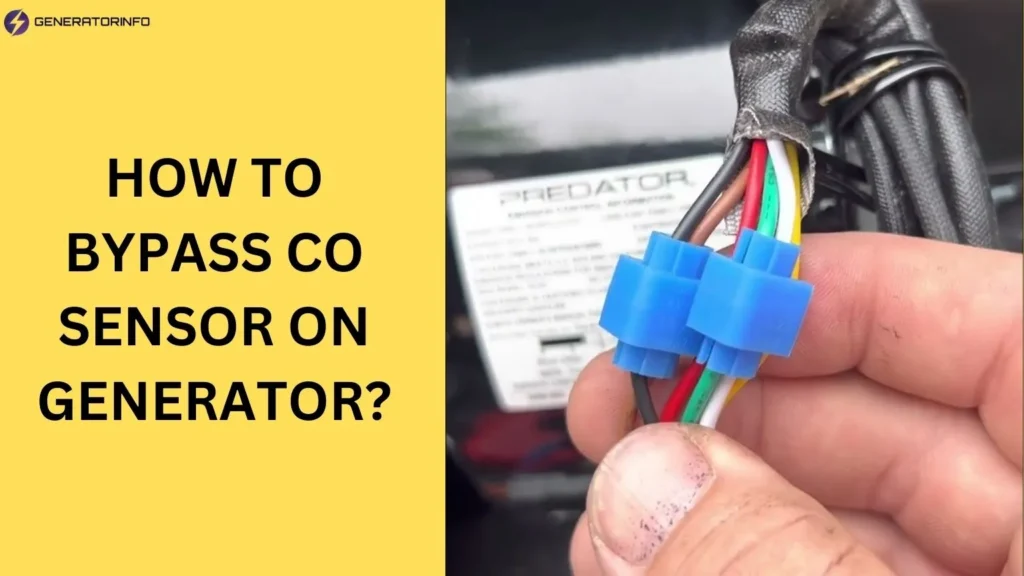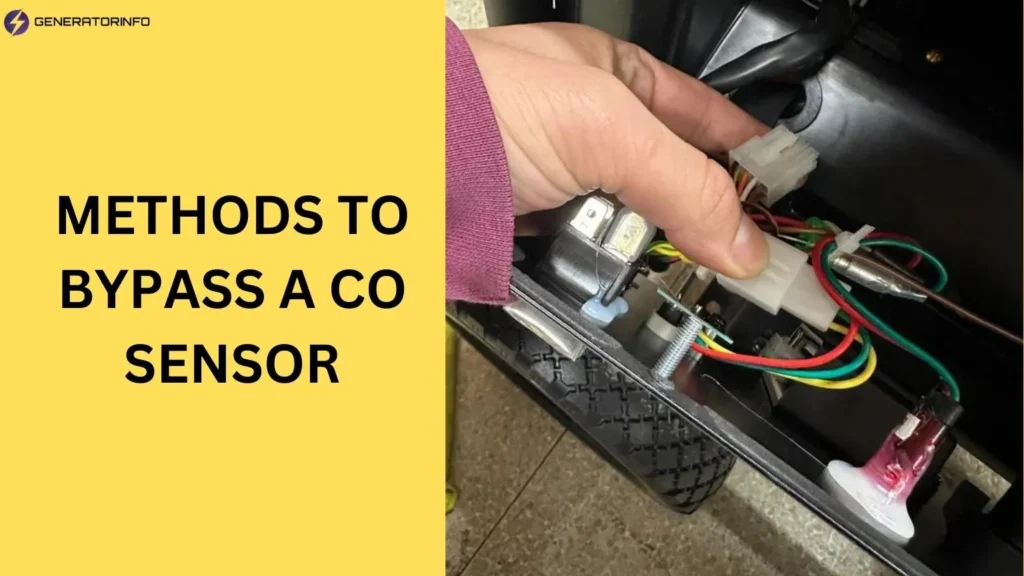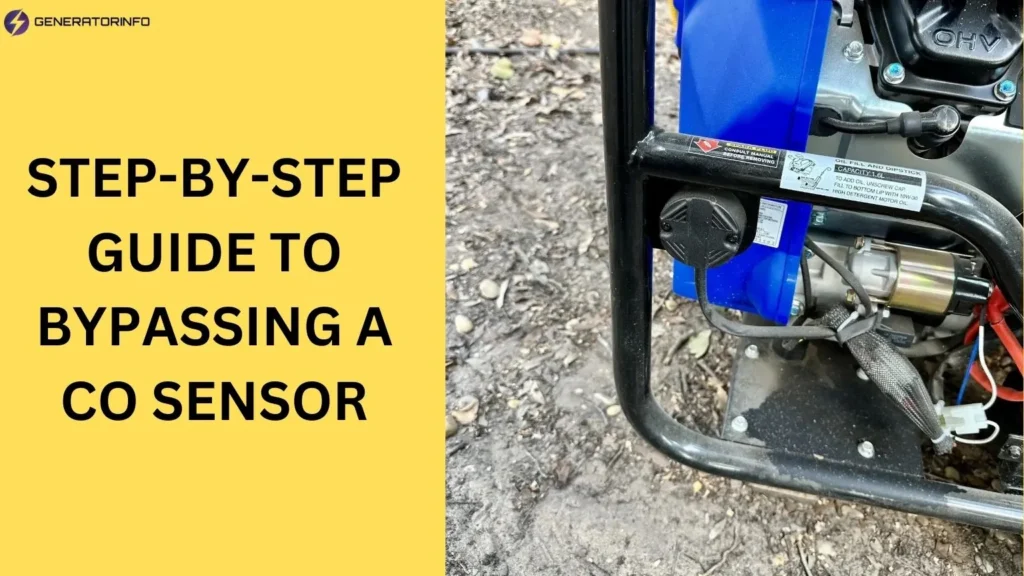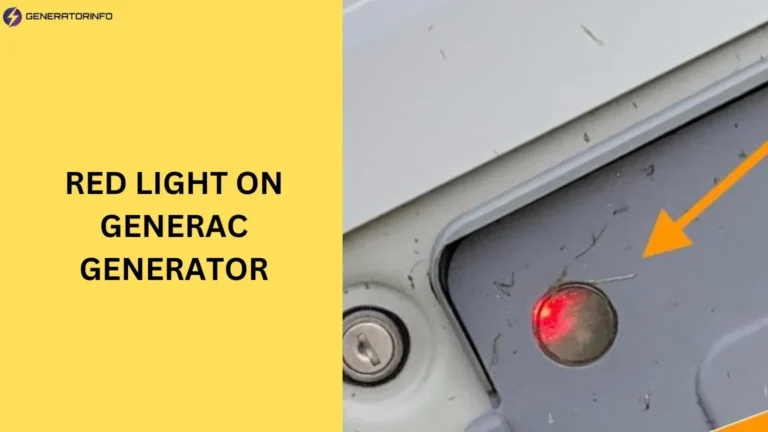How to Bypass CO Sensor on Generator? (Guide) of 2025
How to Bypass Co Sensor on Generator? Generators equipped with CO (carbon monoxide) sensors are designed to protect against the dangers of carbon monoxide poisoning by shutting down the generator when unsafe levels of CO are detected.
However, there are situations where users may need to bypass these sensors, albeit cautiously.
This article will guide you through the process of bypassing a CO sensor on a generator, ensuring safety and legality are prioritized.

Introduction to CO Sensors on Generators
CO sensors on generators are crucial safety features that monitor CO levels in the exhaust gases. They are designed to prevent CO buildup, which can be deadly if inhaled in high concentrations.
These sensors automatically shut down the generator if dangerous CO levels are detected, protecting both users and the environment.
Understanding CO Sensors and Their Importance
CO sensors work by detecting the presence of carbon monoxide in the exhaust fumes of a generator.
They use advanced technology to measure CO levels and trigger an alarm or shutdown mechanism when concentrations exceed safe limits.
This feature is particularly important in enclosed spaces or during extended generator use where CO buildup can occur unnoticed.
How to Bypass Co Sensor on Generator?
Bypassing a CO sensor on a generator involves methods like using resistors to simulate sensor signals or installing external bypass modules.
This is typically done for troubleshooting or under specific circumstances, but it’s crucial to prioritize safety and legality.
Always follow manufacturer guidelines and consider professional advice to avoid risks associated with carbon monoxide exposure.
Why Would You Want to Bypass a CO Sensor?
There are specific scenarios where bypassing a CO sensor might be considered:
- Necessity in emergency situations: In cases where continuous operation of the generator is required to maintain essential services, bypassing may be necessary.
- Testing and troubleshooting: During maintenance or troubleshooting, temporary bypassing can help isolate sensor-related issues.
- Compatibility issues: Some generator modifications or installations may require temporary bypassing to avoid false alarms or shutdowns.
Safety Considerations Before Bypassing
Before proceeding to bypass a CO sensor, it’s essential to consider the following safety precautions:
- Risk of CO exposure: Bypassing a CO sensor increases the risk of CO exposure, which can be fatal. Only bypass sensors if absolutely necessary and under controlled conditions.
- Legal implications: Bypassing CO sensors may violate safety regulations or warranty terms. Check local laws and manufacturer guidelines before proceeding.
- Alternative safety measures: Explore alternative methods to mitigate CO risks without bypassing sensors, such as proper ventilation or relocating the generator.
Methods to Bypass a CO Sensor

There are several methods to bypass a CO sensor on a generator, each with its own considerations:
Using a Dummy Load Method
The dummy load method involves simulating the presence of a functional sensor by using resistors or other electrical components.
This tricks the generator’s control system into thinking the CO sensor is operating normally. Here’s a step-by-step guide:
- Gather Materials: You’ll need resistors that match the specifications of the CO sensor’s output.
- Identify Sensor Wires: Locate the wires connecting the CO sensor to the generator’s control unit.
- Connect Resistors: Attach the resistors in place of the sensor, creating a dummy load.
- Secure Connections: Ensure all connections are secure and insulated to prevent short circuits.
- Test Generator: Start the generator and check if it operates without triggering a CO shutdown.
Installing a Resistor
This method involves placing a specific resistor in the sensor circuit to mimic the electrical characteristics of a functioning CO sensor. Here’s how to do it:
- Determine Resistor Value: Identify the correct resistor value needed to simulate the sensor’s normal output.
- Disconnect Sensor: Carefully disconnect the CO sensor from the generator.
- Insert Resistor: Connect the resistor in place of the sensor, ensuring proper placement in the circuit.
- Insulate Connections: Use electrical tape or heat shrink tubing to insulate the connections.
- Test Operation: Start the generator and monitor its performance to ensure the bypass is successful.
Using an External Bypass Module
Some generators support external modules that can override the CO sensor’s shutdown signal under controlled conditions. Here’s a guide on using an external bypass module:
- Purchase a Bypass Module: Obtain a bypass module compatible with your generator model.
- Read Instructions: Carefully read the module’s installation instructions provided by the manufacturer.
- Locate Sensor Input: Identify where the CO sensor connects to the generator’s control unit.
- Install Module: Connect the bypass module according to the instructions, ensuring all connections are secure.
- Test Generator: Start the generator and check for any error messages or shutdowns.
Step-by-Step Guide to Bypassing a CO Sensor

Bypassing a CO (carbon monoxide) sensor on a generator should be approached with caution to ensure safety and legal compliance. Here’s a detailed guide on how to bypass a CO sensor effectively:
1. Preparation and Safety Measures
Before starting, gather all necessary tools and materials, including resistors, wires, electrical tape, and safety gear. Follow these preparation steps:
- Turn Off the Generator: Ensure the generator is completely turned off and unplugged.
- Ventilation: Work in a well-ventilated area to prevent CO buildup.
- Safety Gear: Wear gloves and safety goggles to protect yourself from electrical hazards.
2. Identifying the CO Sensor Location
Next, locate the CO sensor on your generator. This step may vary depending on the model, but general tips include:
- Consult the Manual: Refer to the generator’s user manual for the exact location of the CO sensor.
- Visual Inspection: Look for a small sensor attached to the exhaust system or control panel.
3. Choosing the Bypass Method
Decide on the most suitable bypass method for your situation. Here are three common methods:
- Dummy Load Method: Using resistors to simulate a functional sensor.
- Installing a Resistor: Placing a specific resistor in the sensor circuit.
- External Bypass Module: Using a commercially available bypass module.
4. Implementing the Bypass
Follow the steps for your chosen method to bypass the CO sensor:
Using the Dummy Load Method
- Gather Materials: Collect resistors matching the sensor’s output specifications.
- Identify Sensor Wires: Locate and disconnect the wires connecting the CO sensor to the control unit.
- Connect Resistors: Attach the resistors to simulate the sensor’s signal.
- Secure Connections: Use electrical tape to insulate the connections.
- Test Generator: Start the generator and check for normal operation.
Installing a Resistor
- Determine Resistor Value: Find the correct resistor value for the sensor’s circuit.
- Disconnect Sensor: Carefully remove the CO sensor from the circuit.
- Insert Resistor: Connect the resistor in place of the sensor.
- Insulate Connections: Insulate all connections with electrical tape.
- Test Operation: Start the generator and ensure it runs without issues.
Using an External Bypass Module
- Purchase Module: Buy a compatible bypass module for your generator model.
- Read Instructions: Follow the manufacturer’s installation instructions carefully.
- Locate Sensor Input: Find the sensor input on the control unit.
- Install Module: Connect the bypass module as instructed.
- Test Generator: Start the generator and verify it operates correctly.
5. Testing the Bypassed CO Sensor
After implementing the bypass, it’s crucial to test the generator to ensure everything works as expected:
- Start the Generator: Turn on the generator and let it run.
- Monitor Operation: Watch for any abnormal behavior or error messages.
- Check for CO Levels: If possible, use a separate CO detector to monitor CO levels and ensure safety.
Legal and Safety Implications
Bypassing CO sensors can have legal and safety implications:
- Legal Compliance: Ensure compliance with local laws and regulations regarding generator safety and emissions.
- Manufacturer Warranty: Bypassing sensors may void the generator’s warranty or insurance coverage.
- Safety Certification: Generators with bypassed sensors may not meet safety certification standards for residential or commercial use.
People also ask
Do I need a co sensor on my generator?
Yes, you need a CO sensor on your generator. CO sensors are crucial safety devices that detect dangerous levels of carbon monoxide, a colorless, odorless gas that can be deadly.
They automatically shut down the generator if CO levels become unsafe, protecting you and others from potential poisoning.
Always prioritize safety by ensuring your generator is equipped with a functioning CO sensor.
How do I turn off the carbon monoxide detector?
Turning off a carbon monoxide detector is not recommended. Carbon monoxide detectors are essential safety devices designed to alert you to dangerous levels of CO gas.
If you suspect a false alarm or need to temporarily silence the detector due to non-emergency situations (like testing or maintenance), refer to the manufacturer’s instructions.
Typically, this involves pressing a reset or silence button on the detector itself.
However, always ensure proper ventilation and safety measures are in place before silencing a CO detector.
How to make a carbon monoxide detector stop beeping?
To make a carbon monoxide detector stop beeping, follow these steps:
Check the Batteries: Replace the batteries if they are low.
Reset the Detector: Press the reset or silence button.
Ventilate the Area: Ensure the space is well-ventilated to eliminate any CO gas.
Inspect for CO Leaks: If the beeping persists, there may be a CO leak. Move to fresh air and call emergency services.
Why is the carbon monoxide light flashing on my generator?
The carbon monoxide light flashing on your generator typically indicates the detection of unsafe CO levels.
This alert is a safety feature to warn you of potential carbon monoxide buildup, which can be dangerous or even fatal.
Ensure proper ventilation immediately, move to a safe area, and shut down the generator.
Investigate the source of CO and consider calling a professional for assistance.
Conclusion
In Conclusion, How to Bypass CO Sensor on Generator? Bypassing a CO sensor on a generator should only be considered in exceptional circumstances where safety and legal compliance are thoroughly assessed.
Prioritize safety measures, legal considerations, and alternative methods to mitigate CO risks before proceeding with any bypassing.






